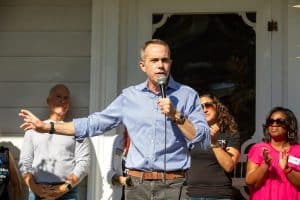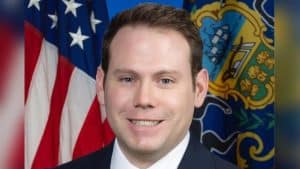Nothing says Welcome Back to School like a $1.1 billion increase in the education budget.
One of the municipalities singled out for additional funding is close to home, as the new budget guarantees the people of one Bucks County community relief from years of onerous taxation. Bristol Township School District has long struggled to provide an adequate education with limited resources. But now, Democratic leadership has moved to put an end to that.
Last week, Governor Shapiro proudly unveiled a block-buster education budget that makes unprecedented reparations to localities starved by prior funding models. “This budget really included an historic increase in K thru twelve basic education funding,” said Chris Lilienthal, Assistant Director of Communications for PSEA (Pennsylvania State Education Association) – the labor union representing 177,000 members, including teachers, support staff, higher education staff, retired teachers, and aspiring educators and student teachers.
Lilienthal added, “As we’ve said many times, the students of this state have waited decades for their policy makers to step up and take bold action to address the funding gaps.”
Democrats in Harrisburg have worked for years to increase the commonwealth level investment in basic education as well as the other educational categories – special education, school safety, student mental health, school facilities, building repairs, technical education and other needs – but it wasn’t until a February 7, 2023, Commonwealth Court ruling declaring Pennsylvania’s educational funding model unconstitutional that any substantive change moved out of the legislature.
Bucks County State Rep. Davis explained, “The Commonwealth has been negligent in adequately funding our public schools for far too long. This has put the onus on local taxpayers to make up the difference and lead to an inequitable school funding system that has left too many children behind.”
The court battle, nearly a decade in the making, mandated that the general assembly under the leadership of Pennsylvania House Democrats and Governor Josh Shapiro, expand exponentially on the educational funding increases begun during Governor Wolf’s administration.
Plaintiffs in the lawsuit, a collection of school districts, interested parties like the NAACP and parents of kids at underfunded schools, were able to demonstrate that the commonwealth’s divestment in education led to educational disparities with some school districts spending nearly $5,000 less per student than their counterparts in wealthier communities. Once forced by the court to increase funding, legislators began arguing about how the budget’s increased funding should be dispersed.
Bryan Allen, Chief of Staff for Representative Davis explained that the current plan – the one which pushed a record breaking $1.1 billion increase in K-12 education out to districts – is based on poverty data collected by schools and reported to the state.
READ: Housing and Education Go Hand in Hand in Our Vision for a Healthy Pennsylvania
The general assembly used this data to identify the municipalities that accumulated the greatest need, over time. Allen explained, “In the 1970’s the state accounted for about 50% of school funding, that dropped to about 30% and leads to inequity … Wealthy areas will have better schools.”
Using the school data, the increase is distributed on two levels. One is an overall increase in funding across the commonwealth, the other component makes up for two harrowing consequences of inadequate funding at the local level – educational inequities for students and a disproportionate burden on local taxpayers.
Lilienthal explained that “$493 million [of the $811 million basic education dollars] in this year’s additional funding was driven out to 348 school districts statewide,” specifically districts that did not come up to the minimum investment required for students to thrive in their academic studies. “$225 million went to school districts based on a variety of factors including student enrollment, ESL students, poverty rates, etc.”
Additional funds were earmarked for “high tax school districts” that shouldered an oppressive burden in education costs for their children.
Lilienthal says because the governor asked for – but did not receive – a $1.8 billion increase to level the playing field, advocates crafted a seven-year plan, beginning with the 2023/24 school year. Lilienthal says that while proponents of equitable funding intend “to drive dollars out to school districts that had been historically underfunded, nothing in the budget said this was part of a seven-year plan.” So each year there’ll be a new assessment of need. “Every year will be a new battle requiring more advocacy.”
That battle over who gets what – this year – is where the political wrangling began. This year, only 11 school districts received the dollars necessary to overcome past inequities. With the exception of the sixteen compensated for 23/24, all other fiscally deficient municipalities will have to wait for the next budget to see if they receive the funding necessary to provide local tax relief as well as educational adequacy.
In other words, the burden for educating Pennsylvania youth in towns crippled by underfunding will continue, leaving lawmakers to prioritize compensation to school districts based on whether the students have fewer educational opportunities, or the property owners pay inequitable taxes or both.
In the case of Bristol Township School District (BTSD), it’s both.
And no, it’s not just Bristol Township that’s hurting – Pennsylvania’s local property taxpayers pay more than taxpayers in 43 of the other states for public education – but curtailing Shapiro’s budget forced lawmakers to grant selective relief. And while Bucks County is one of the wealthiest counties in Pennsylvania, Bristol Township is one of the poorest municipalities in the county. In fact, it’s so overburdened that, according to data supplied by PSEA, Bristol Township leads the nation in local property tax burden as the community struggles to maintain adequate education levels.
BTSD’s shortfall is enormous, with a $1,842,944.77 deficit in adequacy funding and another $487,762.41 lacking to bring the township onto equitable footing for local taxpayers.
Earlier this month when the $1.1 billion increases were announced, several Republican lawmakers accused Democratic lawmakers – including Rep. Davis – of choosing school districts back home for political purposes. But when these numbers are examined, it becomes clear that Bristol Township is receiving the additional funds because they have the greatest need.
The commonwealth is reimbursing $1.6 million of the $2.3 million in shortages identified by the Department of Education. Rep. Davis is pleased that Bristol Township School District (BTSD) has been singled out for remediation.
“Our school district, which has an especially heavy special education burden, had been underfunded for years,” said Davis. “This supplemental payment has helped them to keep all their wonderful programs going strong while avoiding a school real estate tax increase for 2024-25.”
Davis is right, for Bristol Township, the plan is working. The BTSD offices have confirmed there’ll be “no school tax increase for the 2024-2025 year. All staffing levels and school district offerings are preserved in the final budget.”
That final budget looks like a laundry list of options for students that every school district hopes to deliver.
“Programs maintained in the final budget include full-day kindergarten, middle and high school athletics, gifted and honors education, K-12 music and art, and after-school activities and programs,” said Superintendent Michael Nitti. His office also notes that funding will support programs to support students’ emotional and psychological health, professional development, and necessary facility improvements.
“The increased funding was used to offset a tax increase, as well as provide for curriculum revisions, programming improvements and professional development designed to promote student achievement,” Nitti added.
Governor Shapiro pledged to continue repairing disadvantaged school district budgets. The governor’s press secretary, Manuel Bonder, shared their intentions, “The Shapiro Administration is committed to working with the General Assembly to build on this progress in the years to come so we can give every Pennsylvania student the freedom to chart their own course and the opportunity to succeed.”
If the PSEA, Gov. Shapiro, Rep. Davis and their colleagues get their way, Bristol Township and the other ten school districts singled out this year won’t be the only municipalities getting additional funding for equity and tax relief, they’ll just be the first.
Here’s a list of the all 11 school districts (SD) that received additional funding.
Norristown Area SD, Montgomery County; Bristol Township SD, Bucks County; Southeast Delco SD, Delaware County, Lancaster SD, Lancaster County; Wilkes-Barre Area SD, Luzerne County, Wilson Area SD, Northampton County; William Penn SD, Delaware County; Steelton-Highspire SD, Dauphin County; Interboro SD, Delaware County; and Woodland Hills SD, Allegheny County.







